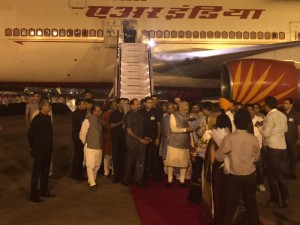 New Delhi, June 1 (IANS): Boosting trade and connectivity, especially people-to-people, is set to be the focus of Prime Minister Narendra Modi’s visit to Bangladesh on June 6-7, as both neighbours prepare to put into operation the long awaited land swap agreement.
New Delhi, June 1 (IANS): Boosting trade and connectivity, especially people-to-people, is set to be the focus of Prime Minister Narendra Modi’s visit to Bangladesh on June 6-7, as both neighbours prepare to put into operation the long awaited land swap agreement.
Modi, who is travelling to Dhaka on a 36-hour visit, will take along West Bengal Chief Minister Mamata Banerjee, who would be present at the signing of the Land Boundary Agreement in Dhaka.
But an accord on sharing the Teesta river waters will not be on the agenda as “much distance is to be travelled” yet by both sides on arriving at an agreement.
It is understood that while the West Bengal government has been kept on board on consultations regarding sharing of the Teesta, which runs through lower riparian neighbour Bangladesh, the necessary support from the state has not been forthcoming.
Modi, during the visit, will flag off the Shillong-Dhaka via Guwahati bus service, and the Kolkata-Dhaka via Agartala bus service, which is expected to give a major boost to people-to-people connectivity between both countries.
While both countries already have the Kolkata to Dhaka train service, Maitree Express, both sides would examine the possibility of a train service between Khulna and Kolkata, sources said. With India and Bangladesh sharing a 4,096-km border, of which over 1,000 km is riverine, there is great potential to boost waterways connectivity.
In a major step forward, both sides are negotiating a coastal shipping agreement, which would allow smaller vessels to go to Bangladesh. Both also have an inland waterways agreement inked in 1972, which has not seen much progress. Indian companies are being invited to set up ports in Bangladesh.
Opening up of more border haats is also set to get a boost. In 2012, India opened a border haat in Meghalaya to boost trade in local produce. There are two border haats on the Meghalaya-Bangladesh border — at Kalaichar (India)-Baliamari (Bangladesh) and at Dalora (Bangladesh)-Balat (India).
In January, both sides inaugurated Tripura’s first border haat in Srinagar – about 140 km south of state capital Agartala. The second border haat in Tripura is to be inaugurated jointly by Modi and Prime Minister Sheikh Hasina during the visit via video conference at Kasba in western Tripura.
Seven more border haats, mostly in Meghalaya, are also on the anvil, which would give trade a major boost, said a source. Both sides have an Integrated Trade Checkpost in Agartala, while the Petrapole Land Check Post is to be converted into an Integrated Check Post.
Bilateral trade, which stands at $6.5 billion is heavily skewed in India’a favour. Both sides are to focus on expanding trade and Indian investment. While talks have been on, on setting up Special Economic Zones in Bangladesh to boost Indian investment, they are at a preliminary stage.
Bangladesh has offered land at different locations for setting up SEZs and around 10 Indian companies have evinced interest to set up industries in Bangladesh.
The inking of the LBA in Dhaka would set off the process of its implementation which is likely to take a few months. The land swap agreement envisages transfer of 111 enclaves with a total area of 17,160.63 acres to Bangladesh, while Dhaka is to transfer 51 enclaves with an area of 7,110.02 acres to India. A 6.1-km undefined border stretch will also be demarcated.
According to a survey in 2011, around 37,000 Indians are in the Bangladeshi enclaves and 14,000 Bangladeshis in the Indian enclaves.
Of the 14,000, very few have chosen to relocate to India as they have integrated with the Bangladesh milieu over the years, a source said. Once the people decide where they want to stay, they will be provided the relevant documents.
Those deciding to remain where they are will be provided local documents and those deciding to move to India will get travel passes to enter India. The settling of the boundary issue has come more than 40 years after the inking of the 1974 Land Boundary Agreement.
Both sides have also settled their maritime border, following an arbitration process. The significance of settling the border is that now no one will question where the border lies. The lurking fear in Bangladesh that India may reopen the border question has been set at rest, a source said. It is also critical in terms of the impact on the people living in the enclaves, who have been stateless since independence.
